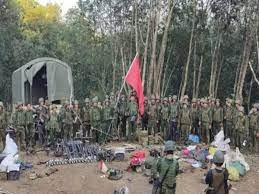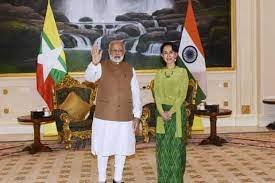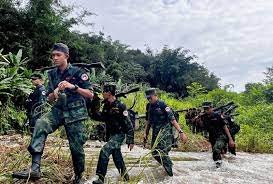
Amidst the tumultuous expanse of Myanmar, a dire tableau unfolds as the clash between pro-democracy forces and the junta intensifies, marked by a rebel offensive ominously dubbed “Operation 1027.” This offensive, set in motion in late October, has not only heightened the intensity of the Myanmar civil war but has also spurred a substantial influx of refugees into Mizoram, prompting grave concerns for India.
Operation 1027, inaugurated in the latter part of October, stands as a strategic maneuver orchestrated by pro-democracy forces, bravely challenging the iron-fisted grip of the military junta. The conflict, now morphed into a full-blown civil war, witnesses the junta’s iron-handed crackdown reaching unprecedented levels, ushering in a dire humanitarian crisis.
The Ongoing Predicament in the Myanmar Civil War
The ongoing civil war in Myanmar has reached a critical juncture, with pro-democracy militias launching Operation 1027 in a bid to counter the junta’s stranglehold. This meticulously coordinated offensive, named after its commencement date, initially targeted junta-controlled territories on the China border, specifically in the northern regions of Shan and Chin State.
Operation 1027: A Pivotal Chapter Unfolds Operation 1027 has become an indelible chapter in the conflict’s narrative. As rebels carve inroads into junta-controlled territories, the offensive precipitates a displacement of thousands. Over 5,000 individuals have sought refuge in Mizoram, India, as a consequence of the escalating conflict.
The Refugee Quandary in Mizoram

The repercussions of this conflict transcend Myanmar’s borders, thrusting Mizoram into the epicenter of a burgeoning refugee crisis. Thousands, predominantly from Chin State, now find sanctuary in Mizoram, their harrowing tales echoing the desperation that propels them across borders.
Transitioning from conflict-ridden zones to makeshift shelters in Mizoram, these refugees bring not only personal belongings but also the scars of a nation rent asunder by internal strife. Mizoram, already contending with a significant refugee population, now grapples with an unprecedented challenge in providing for these new arrivals.
Anxieties Loom for India
Operation 1027 has not merely reshaped the internal contours of Myanmar but also cast a looming shadow on the India-Myanmar border. The rebels’ assertion over key border points raises apprehensions about security, particularly as India treads through delicate diplomatic waters, caught between humanitarian obligations and strategic interests.
The situation presents a double-edged sword for India. On one side, there exists an ethical imperative to extend aid and refuge to those fleeing conflict; on the other, the geopolitical ramifications necessitate a nuanced and calculated response to uphold regional stability.
Rebel Control and Ethnic Conflict
The rebels, identified as constituents of the ethnic Brotherhood, not only challenged the junta’s dominion but also seized strategic border points with India. This development injects an ethical dimension into the conflict, potentially escalating tensions in the region. The control exerted by rebel forces over crucial border areas underscores the intricacy of the conflict and its repercussions on neighboring nations.
Mizoram Refugees and the Humanitarian Crisis
Beyond the geopolitical complexities, the heart of this crisis pulsates with a dire humanitarian urgency. The displaced, many of whom have endured violence and persecution, arrive in Mizoram seeking sanctuary. Non-governmental organizations and local authorities toil ceaselessly to provide shelter, sustenance, and medical aid, yet the sheer scale of the crisis strains available resources.
The plight of the refugees paints a stark tableau of the human toll exacted by Operation 1027. As the international community watches calls for increased humanitarian aid, diplomatic initiatives, and sustainable solutions reverberate.
Global Response and Regional Equilibrium
The gravity of the situation has elicited an international response, with pleas for urgent action and intervention. The plight of Myanmar and its spillover into Mizoram have sparked discussions on the imperative for a coordinated endeavor to address the root causes of the conflict and forge a path toward stability.
Operation 1027’s repercussions extend far beyond national boundaries, serving as a litmus test for regional stability. The delicate power equilibrium in Southeast Asia hangs in the balance, necessitating meticulous deliberation and collaborative efforts to navigate the turbulent waters.
India-Myanmar Border Dynamics

The rebels’ control over key border points prompts inquiries into the dynamics along the India-Myanmar border. India, while emphasizing humanitarian assistance, must negotiate the geopolitical implications of the conflict. The potential spillage and the threat to the border region’s security mandate a nuanced approach by Indian authorities.
A Resounding Call for Unified Action
As the crisis deepens, the imperative for collective action becomes increasingly apparent. The international community must unite to assuage the suffering of the displaced, address the root causes of the conflict, and chart a course toward a more stable and secure future for Myanmar and its neighbors.
In the crucible of Operation 1027, the world is confronted with the harsh realities of a nation torn asunder by internal strife, a humanitarian crisis demanding urgent attention, and the geopolitical intricacies shaping the fate of an entire region.
Conclusion

Operation 1027 has not only exacerbated the civil war in Myanmar but has also triggered a humanitarian crisis with a substantial refugee influx into Mizoram. The concerns for India, both in terms of security and strategic interests, underscore the necessity for a comprehensive regional approach to address the intricacies of this conflict. As the situation continues to evolve, international attention and collaboration are indispensable to finding a sustainable resolution to the Myanmar civil war and mitigating its impact on neighboring regions.










